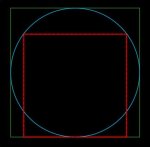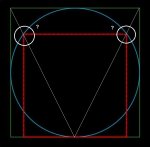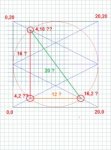Hi all. In a square of 5 units and a circle enclosed by it what is the chord distance involved when the chord distance across equals the chord distance to the ground as in this diagram ... Is it 4 units exactly ?

Cheers and the second part of the question. Does a diagonal line from the top right corner of the square to the centre bottom line meet the point where the red chord hits the blue circle as in the diagram below ?

Cheers and thanks for the help.

Cheers and the second part of the question. Does a diagonal line from the top right corner of the square to the centre bottom line meet the point where the red chord hits the blue circle as in the diagram below ?

Cheers and thanks for the help.

